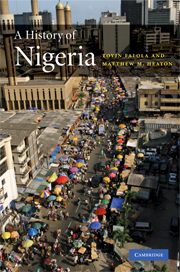Book contents
- Frontmatter
- Contents
- List of illustrations
- List of maps
- Acknowledgments
- Chronology
- Notable people in Nigerian history
- List of abbreviations
- Glossary
- Map 1 Major cities and ethnic groups in present-day Nigeria
- Introduction
- 1 Early states and societies, 9000 BCE – 1500 CE
- 2 Slavery, state, and society, c. 1500 – c. 1800
- 3 Political and economic transformations in the nineteenth century
- 4 Transition to British colonial rule, 1850 – 1903
- 5 Colonial society to 1929
- 6 Nationalist movements and independence, 1929 – 1960
- 7 Instability and civil war, 1960 – 1970
- 8 Oil, state, and society, 1970 – 1983
- 9 Civil society and democratic transition, 1984 – 2007
- 10 Nigeria and Nigerians in world history
- Concluding remarks: corruption, anti-corruption, and the 2007 elections
- Notes
- Selected bibliography
- Index
9 - Civil society and democratic transition, 1984 – 2007
Published online by Cambridge University Press: 05 June 2012
- Frontmatter
- Contents
- List of illustrations
- List of maps
- Acknowledgments
- Chronology
- Notable people in Nigerian history
- List of abbreviations
- Glossary
- Map 1 Major cities and ethnic groups in present-day Nigeria
- Introduction
- 1 Early states and societies, 9000 BCE – 1500 CE
- 2 Slavery, state, and society, c. 1500 – c. 1800
- 3 Political and economic transformations in the nineteenth century
- 4 Transition to British colonial rule, 1850 – 1903
- 5 Colonial society to 1929
- 6 Nationalist movements and independence, 1929 – 1960
- 7 Instability and civil war, 1960 – 1970
- 8 Oil, state, and society, 1970 – 1983
- 9 Civil society and democratic transition, 1984 – 2007
- 10 Nigeria and Nigerians in world history
- Concluding remarks: corruption, anti-corruption, and the 2007 elections
- Notes
- Selected bibliography
- Index
Summary
INTRODUCTION
The military coup that ended the Second Republic and brought General Muhammadu Buhari to power on December 31, 1983, ushered in a new period of military rule in Nigeria that lasted fifteen years. Three military regimes ruled during this period – those of Buhari, General Ibrahim Badamasi Babangida (IBB for short), and General Sani Abacha – before power was finally transferred back, in 1999, to a civilian administration under the leadership of President Olusegun Obasanjo, the former military ruler now turned politician. The three military regimes oversaw the further decline of the Nigerian economy, particularly after the imposition of the Structural Adjustment Program in 1985.
Far from revitalizing the shattered government apparatus left behind by the Second Republic, these regimes presided over the further entrenchment of official and everyday corruption in Nigeria, and sought to maintain power through oppression, coercion, and the manipulation of the democratic transition process. Government officials and their patrons continued to plunder government coffers at the expense of the population, causing many Nigerians to turn to corrupt and illegal activities such as bribe taking, smuggling, armed robbery, and fraudulent schemes in order to make enough money simply to survive. While a few Nigerians became exceedingly wealthy through their corrupt practices, most remained mired in extreme poverty. Since the transfer to democratic rule in 1999, a few of the ills of the Nigerian political, economic, and social situation have seen minimal amelioration, while others continue to plague the country, with no resolution in sight.
- Type
- Chapter
- Information
- A History of Nigeria , pp. 209 - 242Publisher: Cambridge University PressPrint publication year: 2008

